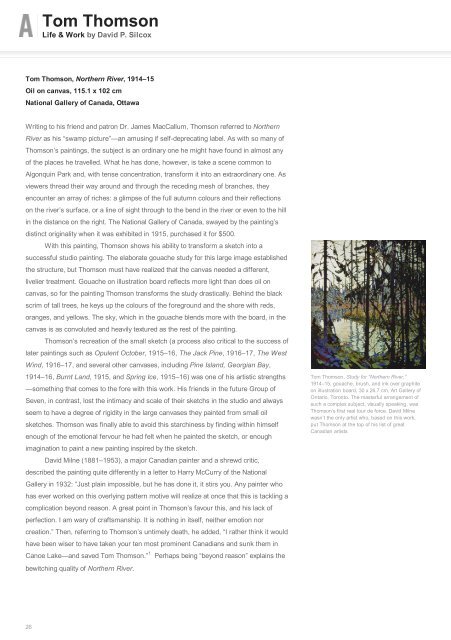Create successful ePaper yourself
Turn your PDF publications into a flip-book with our unique Google optimized e-Paper software.
<strong>Tom</strong> <strong>Thomson</strong><br />
Life & Work by David P. Silcox<br />
<strong>Tom</strong> <strong>Thomson</strong>, Northern River, 1914–15<br />
Oil on canvas, 115.1 x 102 cm<br />
National Gallery of Canada, Ottawa<br />
Writing to his friend and patron Dr. James MacCallum, <strong>Thomson</strong> referred to Northern<br />
River as his “swamp picture”—an amusing if self-deprecating label. As with so many of<br />
<strong>Thomson</strong>’s paintings, the subject is an ordinary one he might have found in almost any<br />
of the places he travelled. What he has done, however, is take a scene common to<br />
Algonquin Park and, with tense concentration, transform it into an extraordinary one. As<br />
viewers thread their way around and through the receding mesh of branches, they<br />
encounter an array of riches: a glimpse of the full autumn colours and their reflections<br />
on the river’s surface, or a line of sight through to the bend in the river or even to the hill<br />
in the distance on the right. The National Gallery of Canada, swayed by the painting’s<br />
distinct originality when it was exhibited in 1915, purchased it for $500.<br />
With this painting, <strong>Thomson</strong> shows his ability to transform a sketch into a<br />
successful studio painting. The elaborate gouache study for this large image established<br />
the structure, but <strong>Thomson</strong> must have realized that the canvas needed a different,<br />
livelier treatment. Gouache on illustration board reflects more light than does oil on<br />
canvas, so for the painting <strong>Thomson</strong> transforms the study drastically. Behind the black<br />
scrim of tall trees, he keys up the colours of the foreground and the shore with reds,<br />
oranges, and yellows. The sky, which in the gouache blends more with the board, in the<br />
canvas is as convoluted and heavily textured as the rest of the painting.<br />
<strong>Thomson</strong>’s recreation of the small sketch (a process also critical to the success of<br />
later paintings such as Opulent October, 1915–16, The Jack Pine, 1916–17, The West<br />
Wind, 1916–17, and several other canvases, including Pine Island, Georgian Bay,<br />
1914–16, Burnt Land, 1915, and Spring Ice, 1915–16) was one of his artistic strengths<br />
—something that comes to the fore with this work. His friends in the future Group of<br />
Seven, in contrast, lost the intimacy and scale of their sketchs in the studio and always<br />
seem to have a degree of rigidity in the large canvases they painted from small oil<br />
sketches. <strong>Thomson</strong> was finally able to avoid this starchiness by finding within himself<br />
enough of the emotional fervour he had felt when he painted the sketch, or enough<br />
imagination to paint a new painting inspired by the sketch.<br />
David Milne (1881–1953), a major Canadian painter and a shrewd critic,<br />
described the painting quite differently in a letter to Harry McCurry of the National<br />
Gallery in 1932: “Just plain impossible, but he has done it, it stirs you. Any painter who<br />
has ever worked on this overlying pattern motive will realize at once that this is tackling a<br />
complication beyond reason. A great point in <strong>Thomson</strong>’s favour this, and his lack of<br />
perfection. I am wary of craftsmanship. It is nothing in itself, neither emotion nor<br />
creation.” Then, referring to <strong>Thomson</strong>’s untimely death, he added, “I rather think it would<br />
have been wiser to have taken your ten most prominent Canadians and sunk them in<br />
Canoe Lake—and saved <strong>Tom</strong> <strong>Thomson</strong>.” Perhaps being “beyond reason” explains the<br />
bewitching quality of Northern River.<br />
Sunset 1915<br />
1<br />
<strong>Tom</strong> <strong>Thomson</strong>, Study for “Northern River,”<br />
1914–15, gouache, brush, and ink over graphite<br />
on illustration board, 30 x 26.7 cm, Art Gallery of<br />
Ontario, Toronto. The masterful arrangement of<br />
such a complex subject, visually speaking, was<br />
<strong>Thomson</strong>’s first real tour de force. David Milne<br />
wasn’t the only artist who, based on this work,<br />
put <strong>Thomson</strong> at the top of his list of great<br />
Canadian artists<br />
26


